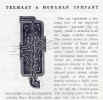|
________________________________________________________
Courtesy of the Oshkosh
Public Library
In 1892 Mr. John Termaat and Mr. Louis Monahan formed a partnership to
build gas and gasoline engines. This business was sold out in 1902 to
Western Malleable & Grey Iron Company. of Milwaukee. Wisconsin. This
firm was later to become the Simplicity Engine Company of Port
Washington, Wisconsin. In
1903 Mr. Termaat and Mr. Monahan again organized another engine company
called T&M. Along with a partner, E. Homer Fahrney, their business
consisted
mainly
of small marine engines. These proved very successful; larger and larger
marine engines followed using multiple cylinders up to a large 190HP, 4
cylinder.1912
was the year that T&M built their first 4 cycle engine with a 2 ½
inch bore and 3 1/2 inch stroke. By 1906 the T&M Company was
building small engine-driven generators for farm and home use. Just
before WW I the U.S. Army contracted the company to build 2000 small
engine-driven generators for them. Also about this same time they began building
engine-driven pumps for farm and
home use. These were built using different types of pumps. Some of their
pumps were used to help build the Panama Canal, and
some were with Admiral Byrd
on his expedition to the South Pole. 1914
was the year that T&M came out with the hopper-cooled, 4 cycle farm engine. It was also the same year that T&M
marine engine business reorganized
under the name of Universal Motor Company. Just what really happened we were not able to find out for sure.
However, it appears that the marine
engine business became Universal, and Mr. Termaat and Mr. Monahan retained the T&M Mfg. Company and built farm
type engines under the old T&M name.
These engines were built in 1, 1 1/2, 2 1/2, 4, 6, 9, and 12 HP sizes. The engines up to 4 HP used a spark plug and
jump-spark ignition. Their engines
6 HP and over used a make-and-break igniter ignition system. The life of T&M was actually very short. Just
how many engines were built we
were
not able to find. However, judging by the number of T&M engines in
collector's hand today, there probably were not a great number of
T&M engines built. After building these engines from 1914 until
1920, in 1919 the company came out with a new 1 1/2 and 3 HP engine
called the "Wiscona Pep".
These were
very unusual looking engines with two fuel tanks
built into the top of the water hopper. One tank for gasoline, one for
kerosene. The engine could run on either one. In 1920 all ads and
material listed T&M and Wiscona Pep under the trade name of
Wiscona Pep Motor and Parts Company, with Jos. Hauser as President.
Probably the company was sold to him. By 1926 there was no mention of
Wiscona Pep Company in the trade journals,
or in the Winnebago County directory. So it is very probable that they
went out of business in 1925. This would give T & M farm engine
building business a life of only 12 years, a very short one indeed.
Universal Motor Company was a different story. They continued a fast
growth, building many marine engines until they were the number one
builder of auxiliary power plants for sailboats in all the world. During
WW II they built 12,000 engines for powering lifeboats. Universal Motor
Company was sold in 1961 to the J M Nash Company of Milwaukee. Today it
still supplies auxiliary power plants for sailboats using a basic engine
block supplied by an outside company. They refit with their accessories
to make it useable for a very successful power plant. The company is
known today as Universal Motors Div., Medalist Industries.

_______________________________________________________________________________________






_______________________________________________________________________________________
|